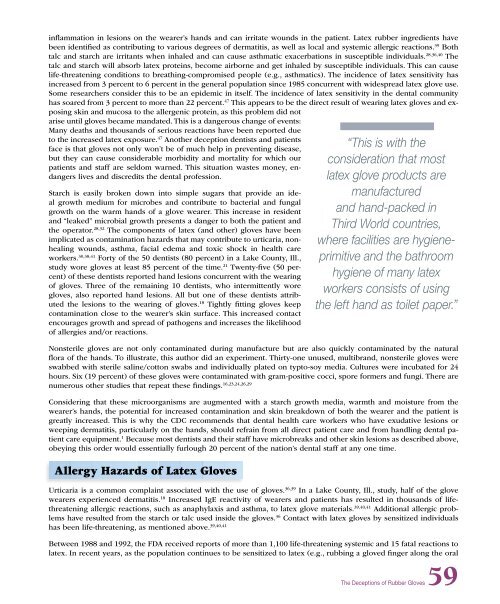PDF Version - Glidewell Dental Labs
PDF Version - Glidewell Dental Labs
PDF Version - Glidewell Dental Labs
Create successful ePaper yourself
Turn your PDF publications into a flip-book with our unique Google optimized e-Paper software.
inflammation in lesions on the wearer’s hands and can irritate wounds in the patient. Latex rubber ingredients have<br />
been identified as contributing to various degrees of dermatitis, as well as local and systemic allergic reactions. 39 Both<br />
talc and starch are irritants when inhaled and can cause asthmatic exacerbations in susceptible individuals. 28,36,40 The<br />
talc and starch will absorb latex proteins, become airborne and get inhaled by susceptible individuals. This can cause<br />
life-threatening conditions to breathing-compromised people (e.g., asthmatics). The incidence of latex sensitivity has<br />
increased from 3 percent to 6 percent in the general population since 1985 concurrent with widespread latex glove use.<br />
Some researchers consider this to be an epidemic in itself. The incidence of latex sensitivity in the dental community<br />
has soared from 3 percent to more than 22 percent. 47 This appears to be the direct result of wearing latex gloves and exposing<br />
skin and mucosa to the allergenic protein, as this problem did not<br />
arise until gloves became mandated. This is a dangerous change of events:<br />
Many deaths and thousands of serious reactions have been reported due<br />
to the increased latex exposure. 47 Another deception dentists and patients<br />
face is that gloves not only won’t be of much help in preventing disease,<br />
but they can cause considerable morbidity and mortality for which our<br />
patients and staff are seldom warned. This situation wastes money, endangers<br />
lives and discredits the dental profession.<br />
Starch is easily broken down into simple sugars that provide an ideal<br />
growth medium for microbes and contribute to bacterial and fungal<br />
growth on the warm hands of a glove wearer. This increase in resident<br />
and “leaked” microbial growth presents a danger to both the patient and<br />
the operator. 28,32 The components of latex (and other) gloves have been<br />
implicated as contamination hazards that may contribute to urticaria, nonhealing<br />
wounds, asthma, facial edema and toxic shock in health care<br />
workers. 30,38,41 Forty of the 50 dentists (80 percent) in a Lake County, Ill.,<br />
study wore gloves at least 85 percent of the time. 21 Twenty-five (50 percent)<br />
of these dentists reported hand lesions concurrent with the wearing<br />
of gloves. Three of the remaining 10 dentists, who intermittently wore<br />
gloves, also reported hand lesions. All but one of these dentists attributed<br />
the lesions to the wearing of gloves. 18 Tightly fitting gloves keep<br />
contamination close to the wearer’s skin surface. This increased contact<br />
encourages growth and spread of pathogens and increases the likelihood<br />
of allergies and/or reactions.<br />
Nonsterile gloves are not only contaminated during manufacture but are also quickly contaminated by the natural<br />
flora of the hands. To illustrate, this author did an experiment. Thirty-one unused, multibrand, nonsterile gloves were<br />
swabbed with sterile saline/cotton swabs and individually plated on typto-soy media. Cultures were incubated for 24<br />
hours. Six (19 percent) of these gloves were contaminated with gram-positive cocci, spore formers and fungi. There are<br />
numerous other studies that repeat these findings. 16,23,24,26,29<br />
Considering that these microorganisms are augmented with a starch growth media, warmth and moisture from the<br />
wearer’s hands, the potential for increased contamination and skin breakdown of both the wearer and the patient is<br />
greatly increased. This is why the CDC recommends that dental health care workers who have exudative lesions or<br />
weeping dermatitis, particularly on the hands, should refrain from all direct patient care and from handling dental patient<br />
care equipment. 1 Because most dentists and their staff have microbreaks and other skin lesions as described above,<br />
obeying this order would essentially furlough 20 percent of the nation’s dental staff at any one time.<br />
Allergy Hazards of Latex Gloves<br />
“This is with the<br />
consideration that most<br />
latex glove products are<br />
manufactured<br />
and hand-packed in<br />
Third World countries,<br />
where facilities are hygieneprimitive<br />
and the bathroom<br />
hygiene of many latex<br />
workers consists of using<br />
the left hand as toilet paper.”<br />
Urticaria is a common complaint associated with the use of gloves. 36,39 In a Lake County, Ill., study, half of the glove<br />
wearers experienced dermatitis. 18 Increased IgE reactivity of wearers and patients has resulted in thousands of lifethreatening<br />
allergic reactions, such as anaphylaxis and asthma, to latex glove materials. 39,40,41 Additional allergic problems<br />
have resulted from the starch or talc used inside the gloves. 36 Contact with latex gloves by sensitized individuals<br />
has been life-threatening, as mentioned above. 39,40,41<br />
Between 1988 and 1992, the FDA received reports of more than 1,100 life-threatening systemic and 15 fatal reactions to<br />
latex. In recent years, as the population continues to be sensitized to latex (e.g., rubbing a gloved finger along the oral<br />
The Deceptions of Rubber Gloves59

















